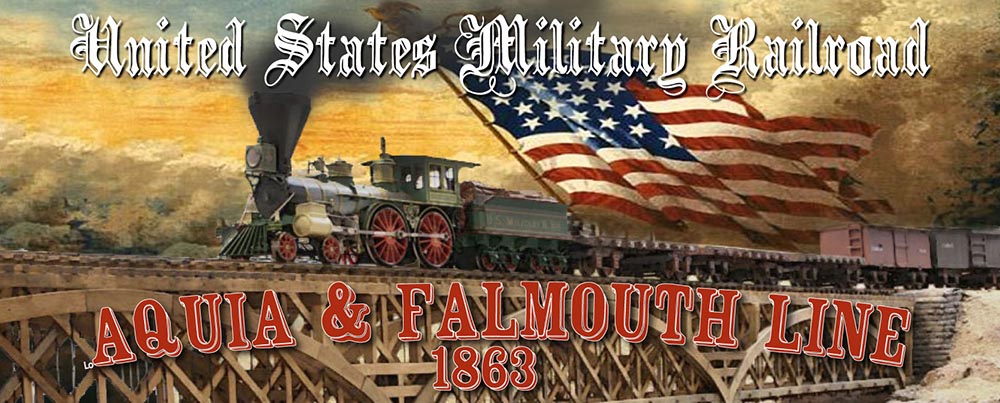This page from Patrick Brigade's Provost Marshall Log contains some message traffic where medical officers were trying to locate their medical supplies that were allegedly delievered to Aquia.
The messages indicate that there are two separate locations, Yuba Dam and Aquia Wharf. Heretofore, I thought they were the same place, while the wharf down river was called Burnside Wharf. Now I am confused. Is the down river wharf actually Yuba Dam and the main wharf called Aquia Landing?

This message describes a plank road at Aquia Landing. At the White Oak Civil War Museum I learned of corduroy roads built near the fortifications at Accokeek Creek.
The photo shows a section of a replica corduroy road at the White Oak Museum. A plank road is similar except that the logs are split to provide a flat surface.
Stafford County is building a park at the site of the former Accokeek fortifications and actually found a section of existing corduroy road preserved under about 3 feet of dirt.
I plan to add a section of corduroy road to the layout at Brook and perhaps some other locations. I found some weeds growing near my house that will make excellent logs for a corduroy road.
This message is from a log of trains received at Warrenton on the USMRR controlled O&A RR. Most of the log entries list trains hauled by one locomotive. But this entry describes a train pulled by two engines, Minoh and Vulcan arrived at 1:20 PM with 18 cars: 12 with forage, 1 with com (I assume commissary stores), 5 with clothing. So the USMRR did double head engines at times.


Ken Pitts from the White Oak Civil War Museum wrote the following reply to my query about Yuba Dam,
ReplyDelete"....As far as your question, I checked with D. P. Newton to make sure I was right, but Yuba Dam wharf was 1 1/2 miles south of Aquia landing. The engineers called it Yuba Dam and the military called it Burnside's Wharf. There are still some old pilings in the river where the wharf was located. D. P. said that some maps show this wharf as being further down the river. Hope this helps, and thanks for the files. D. P. and I are going to look at them tomorrow at the museum.
Thanks again,
Ken"
Dave Schneider sent me a note with the following quotes from the OR.
ReplyDeleteAccording to a report by McCallum to Stanton, dated 4/7/63, it was stated that:
The Richmond, Fredericksburg, and Potomac Railroad.
On the 17th of November last this line was again taken possession of by the Government. The old wharf having been destroyed, a new one 1,000 feet long and sixteen feet wide was immediately rebuilt and the first locomotive was landed on the 24th of November. On this day we commenced running trains to Potomac Creek, and on the 28th of November the high bridge over that stream was completed and trains were run to Falmouth. All the buildings at Aquia had been burned and the main tracks and sidings immediately around the station were so much injured by the fire that they had to be relaid. The heavy business about to be thrown upon this line rendered a large increase of sidings necessary, both at Aquia and at points along the line. The total length of main track and sidings laid is about three miles.
It was soon ascertained that a single wharf on the site of the old one, even with the large addition projected and since built, would not be sufficient to meet the demands of the service; therefore it was deter- mined to build a branch railroad to Yuba Dam one mile and a half in length, where a wharf has been built of sufficient capacity to hold twenty-four cars. Vessels drawing ten feet and a half of water can come up to it at low tide. By this arrangement the capacity of the railroad has been increased nearly one-half, and for a sudden movement of troops it will prove invaluable. By direction of Brigadier-General Haupt the buildings upon the wharf and most of the buildings on shore were erected by the railroad force, a large amount of suitable material having been prepared beforehand; and while in doing this much has been added to our expenditures, the expenses of the post quartermaster have been correspondingly reduced.
McCallum mentions it again in his final report (1866):
In April, 1862, the Richmond, Fredericksburg and Potomac Rail road was opened from Aquia Creek to Fredericksburg, fifteen miles, and operated to supply the forces stationed at Fredericksburg. The road was abandoned September 7, with the loss of one engine, fifty-seven cars, and a small quantity of material. On the 18th of November repairs were again commenced, and the road was opened on the 28th to Falmouth, opposite Fredericksburg, and was used to supply the Army of the Potomac until June, 1863. A very large amount of work was required not only to the railroad, but to the wharves at Aquia Creek, all of which had been burned when this line was abandoned by our forces. The limited accommodations for receiving and delivering freight and passengers at Aquia rendered an increase of wharf room and tracks necessary, and a new wharf, afterward named Yuba Dam, was completed in February, one mile below Aquia Creek wharf, and the necessary tracks laid from the main road to it. Vessels drawing ten feet and a half of water could land at the new wharf at low tide, while there was only eight and a half feet at high water at the old one. This improvement proved to be a valuable acquisition to the means of supplying the army. The road continued to be used without interruption until June, 1863, when it was abandoned with small loss of material, but the bridges, buildings, and wharves were soon afterward burned by the enemy.